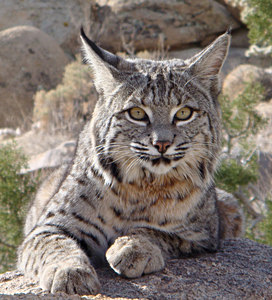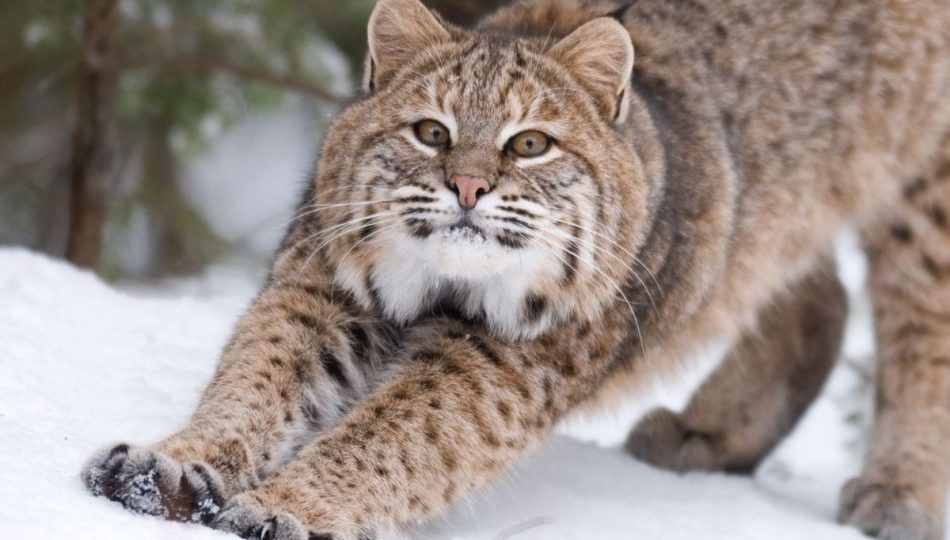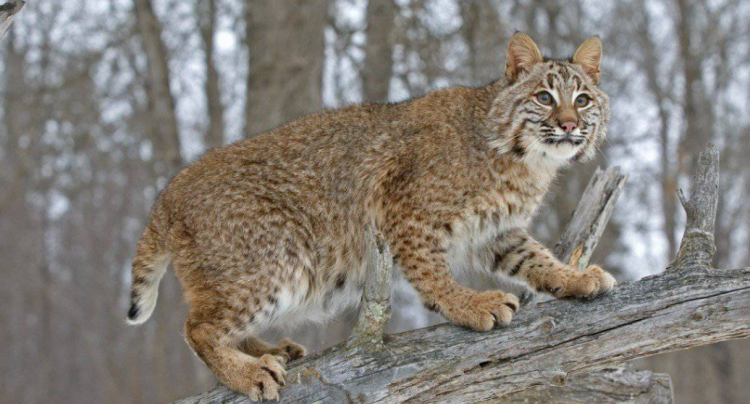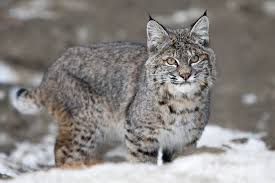Animals
Discover the Largest Bobcats Ever: Exploring Size Variations in Bobcat Species

Discover the Largest Bobcats Ever: Exploring Size Variations in Bobcat Species
Bobcats, the elusive and captivating wild cats found across North America, have long intrigued researchers and wildlife enthusiasts alike. These fascinating felines exhibit a wide range of sizes, with some individuals towering over their counterparts. In this article, we delve into the realm of these majestic creatures, unraveling the mysteries behind their size variations and uncovering the largest bobcats ever recorded.
Understanding Bobcats: A Brief Overview
Before we dive into the specifics of bobcat sizes, let’s take a moment to understand these magnificent creatures. Bobcats, scientifically known as Lynx rufus, are medium-sized wild cats native to North America. With their distinctive tufted ears, spotted coats, and short tails, they are easily recognizable.
Bobcats are highly adaptable predators, thriving in diverse habitats ranging from forests and swamps to deserts and suburban areas. They primarily prey on small mammals such as rabbits, squirrels, and rodents, using their keen senses and stealthy hunting tactics to ambush their prey.
Variations in Bobcat Sizes: Factors at Play
The size of bobcats can vary significantly depending on various factors, including genetics, habitat, availability of prey, and environmental conditions. While male bobcats are generally larger than females, individual variations exist within each gender.
- Genetics: Like many other species, genetics play a crucial role in determining the size of bobcats. Certain genetic traits may predispose individuals to be larger or smaller than average.
- Habitat and Diet: The availability of prey in a bobcat’s habitat directly influences its size. Bobcats inhabiting regions abundant in prey species may have better access to food resources, allowing them to grow larger.
- Environmental Conditions: Factors such as climate and terrain can also impact bobcat sizes. Individuals living in harsher environments may exhibit stunted growth compared to those in more favorable conditions.
- Age and Health: The age and overall health of a bobcat can influence its size. Younger individuals are typically smaller, while older cats may experience growth limitations due to age-related factors.
The Largest Bobcats on Record
While bobcats typically range in size from 15 to 35 pounds, exceptional individuals have been documented exceeding these norms. Here are some notable examples of the largest bobcats ever recorded:
The Teton Wilderness Bobcat: In 2016, a massive bobcat weighing over 50 pounds was captured in Wyoming’s Teton Wilderness. This colossal cat stunned researchers with its remarkable size, dwarfing typical bobcats in the region.

The Texas Giant: In 2019, a Texan rancher reported encountering a bobcat of extraordinary proportions on his property. Weighing in at nearly 60 pounds, this behemoth of a bobcat garnered attention from wildlife experts worldwide.

The California Titan: California is home to its fair share of oversized bobcats, with reports of individuals weighing upwards of 40 pounds. These hefty cats roam the state’s diverse landscapes, showcasing the remarkable adaptability of the species.

While these exceptional specimens represent outliers in the bobcat population, they offer valuable insights into the species’ potential for size variation.
Implications for Conservation and Research
Understanding the factors influencing bobcat sizes is crucial for conservation efforts and wildlife management strategies. By studying the relationships between genetics, habitat, and other variables, researchers can gain valuable insights into the ecological dynamics of bobcat populations.
Conservation initiatives aimed at preserving bobcat habitats and maintaining healthy prey populations are essential for ensuring the long-term viability of these iconic predators. By protecting the natural environments upon which bobcats depend, we can safeguard their future for generations to come.
Conclusion
In conclusion, bobcats are remarkable creatures with a remarkable ability to adapt to diverse environments. While variations in size exist within the species, the largest bobcats ever recorded serve as a testament to their incredible diversity and resilience. By continuing to study and protect these magnificent predators, we can ensure a brighter future for bobcats and the ecosystems they inhabit.
FAQs About Bobcats
Are bobcats dangerous to humans?
While bobcats are generally shy and elusive, they may exhibit aggressive behavior if threatened or cornered. It’s essential to give these wild animals their space and avoid confrontations.
What do bobcats eat?
Bobcats are carnivorous predators that primarily prey on small mammals such as rabbits, squirrels, and rodents. They may also consume birds, reptiles, and occasionally deer.
How far can bobcats roam?
Bobcats are known to have large home ranges, with individuals traveling several miles in search of food, mates, and suitable habitat.
Do bobcats make good pets?
Bobcats are wild animals and are not suitable as pets. Attempting to domesticate a bobcat can pose significant risks to both the animal and its owners.
Are bobcats endangered?
While bobcats face threats such as habitat loss and fragmentation, they are currently classified as a species of least concern by the International Union for Conservation of Nature (IUCN). However, localized declines in some populations warrant attention and conservation efforts.
How can I help protect bobcats?
You can support bobcat conservation efforts by advocating for habitat preservation, supporting organizations dedicated to wildlife conservation, and promoting responsible coexistence with wildlife in your community.
Are bobcats related to domestic cats?
Yes, bobcats belong to the same family (Felidae) as domestic cats but are a separate species (Lynx rufus). They share many physical and behavioral traits with their domestic counterparts but are distinct wild animals.
Verified Source References:
- National Geographic: https://www.nationalgeographic.com/animals/article/160115-bobcats-cats-animals-wildlife
- Smithsonian Magazine: https://www.smithsonianmag.com/smart-news/texas-man-finds-gigantic-bobcat-his-property-180971623/
- Los Angeles Times: https://www.latimes.com/local/lanow/la-me-ln-large-bobcat-20180912-story.html
Animals
Baby Robin: Five Facts and Cute Pictures of Chirpy Robin Nestlings
Animals
Guinea Pig Teeth: All You Need to Know About Guinea Pig Dental Care

Guinea Pig Teeth: All You Need to Know About Guinea Pig Dental Care
Guinea pigs are adorable and gentle pets, but their dental health often goes overlooked. Just like humans, these furry friends require proper dental care to ensure they lead happy and healthy lives. In this comprehensive guide.
we’ll delve into everything you need to know about guinea pig dental care, from understanding their unique dental anatomy to providing essential dental maintenance tips.
Guinea pigs have unique dental needs that necessitate special care and attention from their owners.
Their teeth grow continuously throughout their lives, requiring proper maintenance to prevent overgrowth, misalignment, or other dental problems.
Unlike humans, guinea pigs’ teeth lack roots and are open-rooted, meaning they grow continuously to compensate for wear from chewing.
To maintain your guinea pig’s dental health, provide a balanced diet rich in hay, fresh vegetables, and high-quality pellets. These foods help wear down their teeth naturally and provide essential nutrients for dental health.
Additionally, regular veterinary check-ups are essential to monitor your guinea pig’s dental condition and address any emerging issues promptly.
By prioritizing proper dental care, you can ensure your guinea pig enjoys a happy, healthy life free from the discomfort and complications associated with dental problems. Remember, a little attention to dental care goes a long way in keeping your beloved pet smiling brightly for years to come. Let’s dive in!
Understanding Guinea Pig Dental Anatomy
Before delving into dental care practices, it’s crucial to understand the unique dental anatomy of guinea pigs. These small rodents have continuously growing teeth, known as hypsodont teeth.
Unlike humans, whose teeth stop growing after a certain point, guinea pigs’ teeth grow continuously throughout their lives. This characteristic makes dental care particularly important for them.
Guinea pigs have a total of 20 teeth, consisting of incisors, molars, and premolars.
Their incisors, the front teeth, are particularly prominent and essential for grasping and cutting food. Behind the incisors are the molars and premolars, which are responsible for grinding and chewing food into smaller, digestible pieces.

Signs of Dental Problems in Guinea Pigs
Detecting dental issues in guinea pigs can be challenging, as these animals are adept at hiding signs of discomfort.
However, there are several indicators that may suggest your guinea pig is experiencing dental problems:
-
Loss of Appetite: A sudden decrease in appetite could indicate dental pain or difficulty chewing.
- Weight Loss: If your guinea pig is losing weight despite having a consistent diet, it may be due to dental issues affecting their ability to eat.
- Excessive Drooling: Drooling or excessive salivation can be a sign of dental discomfort.
- Changes in Behavior: Watch out for changes in your guinea pig’s behavior, such as lethargy, reluctance to eat, or increased irritability, which could signal underlying dental issues.

Essential Dental Care Practices for Guinea Pigs
Maintaining good dental hygiene is crucial for preventing dental problems in guinea pigs.
Here are some essential dental care practices to incorporate into your pet care routine:
Provide Chew Toys:
Guinea pigs need to chew on hard objects to wear down their continuously growing teeth. Offer safe chew toys made of untreated wood or chewable materials to help keep their teeth trimmed and healthy.
Offer Hay:
High-quality hay should make up the majority of your guinea pig’s diet. The fibrous texture of hay encourages chewing, which aids in wearing down their teeth naturally.
Monitor Diet:
Ensure your guinea pig’s diet consists of a variety of fresh vegetables, pellets formulated for guinea pigs, and limited fruits. Avoid feeding them sugary or sticky treats, as these can contribute to dental problems.
Regular Veterinary Check-ups:
Schedule regular check-ups with an exotic animal veterinarian who has experience with guinea pigs.
They can perform dental examinations and address any issues before they escalate.
Conclusion
Proper dental care is essential for maintaining the health and well-being of your guinea pig.
By understanding their unique dental anatomy and implementing essential dental care practices you can help ensure your furry friend enjoys a happy and healthy life free from dental problems.
FAQs (Frequently Asked Questions)
How often should I trim my guinea pig’s teeth?
Guinea pigs’ teeth typically wear down naturally with proper diet and chewing habits. However, if your guinea pig has dental issues, your veterinarian may recommend periodic teeth trimming under sedation.
Can I use human toothpaste to brush my guinea pig’s teeth?
No, human toothpaste contains ingredients that are harmful to guinea pigs if ingested. Stick to using a soft-bristled toothbrush and plain water for cleaning their teeth.
Are there any supplements I can give my guinea pig to promote dental health?
While a balanced diet rich in hay and vegetables is usually sufficient for maintaining dental health, your veterinarian may recommend specific supplements if your guinea pig has dental deficiencies.
How can I tell if my guinea pig is in dental pain?
Guinea pigs are adept at hiding signs of pain, but some common indicators include decreased appetite, weight loss, drooling, and changes in behavior.
Can dental problems in guinea pigs be hereditary?
Yes, dental issues in guinea pigs can sometimes have a genetic component. If you’re considering adopting a guinea pig, inquire about its dental history if possible.
Are there any foods that can help prevent dental problems in guinea pigs?
Fibrous foods like hay and crunchy vegetables can help promote dental health by encouraging natural wear and tear on their teeth.
What should I do if I suspect my guinea pig has a dental problem?
If you notice any signs of dental issues in your guinea pig, such as changes in eating habits or behavior, consult with a veterinarian experienced in treating exotic animals as soon as possible. Early intervention is key to preventing dental problems from worsening.
References:
- American Veterinary Dental Society. (n.d.). Dental Anatomy of Guinea Pigs. https://www.avds-online.org/guinea-pigs/
- PDSA. (2022). Dental Care for Guinea Pigs. https://www.pdsa.org.uk/taking-care-of-your-pet/looking-after-your-pet/small-pets/dental-care-for-guinea-pigs
Animals
You Can Help Scientists Spot Walruses from Space: Citizen Science in Action

You Can Help Scientists Spot Walruses from Space: Citizen Science in Action
A Call to Citizen Scientists
Are you ready to embark on a journey that combines your love for animals with the power of technology? Imagine being able to contribute to wildlife conservation efforts right from the comfort of your own home.
Well, get ready, because thanks to advancements in satellite imagery and the rise of citizen science initiatives, you can now play a crucial role in protecting one of the most iconic creatures of the Arctic

Understanding the Importance of Walruses
Before we dive into how you can help, let’s take a moment to appreciate why walruses matter. These magnificent marine mammals play a vital role in the Arctic ecosystem.
From their distinctive tusks used for foraging and communication to their massive bodies that provide food for predators like polar bears, walruses are integral to maintaining the delicate balance of the Arctic food web.
However, walruses face numerous threats, including climate change, habitat loss, and human disturbance. As sea ice continues to diminish due to rising temperatures, walruses are forced to haul out onto land in large numbers, leading to overcrowding and increased vulnerability to predators and other dangers.
The Power of Satellite Technology
Fortunately, modern technology offers a glimmer of hope for these majestic creatures. Satellite imagery provides researchers with a bird’s-eye view of vast stretches of Arctic coastline, allowing them to monitor walrus populations and their habitats with unprecedented accuracy.
By analyzing these images, scientists can track changes in population size, distribution, and behavior over time.
Enter Citizen Science
This is where you come in. Citizen science projects harness the collective power of volunteers worldwide to assist scientists in their research endeavors.
By participating in these projects, you can contribute valuable data that enhances our understanding of walrus ecology and supports conservation efforts.
One such project that has gained traction in recent years is the Walrus Watcher initiative. Developed by researchers at the University of Alaska Fairbanks in collaboration with partners such as NASA and the US Geological Survey, Walrus Watcher enlists the help of volunteers to identify and count walruses in satellite images.
How You Can Get Involved

Participating in the Walrus Watcher project is easy and requires no prior experience. Here’s how you can join the effort:
- Sign Up: Visit the Walrus Watcher website and create an account to gain access to the project’s online platform.
- Training: Complete a brief training module that teaches you how to identify walruses and distinguish them from other objects in satellite images.
- Image Analysis: Once you feel comfortable, dive into the image analysis process. You’ll be presented with satellite images captured by NASA’s Landsat satellites, and your task will be to mark and count the walruses you spot.
- Submit Your Findings: After analyzing an image, submit your findings through the online platform. Your data will be compiled with observations from other volunteers and used by researchers to improve their understanding of walrus populations.
- Spread the Word: Share your involvement in the Walrus Watcher project with friends, family, and social media followers to encourage others to join the cause.
The Impact of Your Contributions
By participating in citizen science projects like Walrus Watcher, you are making a tangible difference in the conservation of walruses and their Arctic habitat.
Your contributions help researchers track population trends, identify critical feeding and breeding areas, and assess the effectiveness of conservation measures.
Furthermore, engaging in citizen science can foster a sense of connection and stewardship toward the natural world.
By actively participating in scientific research, you become a stakeholder in the preservation of our planet’s biodiversity, empowering yourself and others to take meaningful action.
Conclusion:
Be a Walrus Watcher
In conclusion, the partnership between technology and citizen science offers a powerful tool for wildlife conservation.
By lending your time and expertise to projects like Walrus Watcher, you become an integral part of the solution to protect vulnerable species like the walrus.
So, what are you waiting for? Join the ranks of citizen scientists today and help researchers spot walruses from space. Together, we can make a difference for the future of Arctic wildlife and ecosystems.
FAQs: FREQUENTLY ASKED QUESTIONS
How often do I need to participate in the Walrus Watcher project?
You can participate in the project as often as you like. Whether you have a few minutes or a few hours to spare, your contributions are valuable.
Do I need any special equipment or software to join the project?
No, all you need is a computer or mobile device with internet access. The Walrus Watcher platform is user-friendly and accessible to volunteers of all skill levels.
Is there a minimum age requirement to participate in the project?
While there is no minimum age requirement, younger volunteers may need assistance from a parent or guardian to complete the training and analysis tasks.
How long does it take to complete the training module?
The training module typically takes less than an hour to complete. It consists of interactive tutorials and quizzes to help you become familiar with walrus identification.
Can I participate in the project if I live outside of the Arctic region?
Absolutely! The Walrus Watcher project welcomes volunteers from all around the world. Whether you’re in Alaska or Australia, your contributions are valuable.
What happens to the data I submit through the Walrus Watcher platform?
The data you submit is used by researchers to improve our understanding of walrus populations and inform conservation efforts. It may be published in scientific journals or shared with government agencies and conservation organizations.
How can I stay updated on the latest news and developments from the Walrus Watcher project?
You can follow the project’s official website and social media channels for updates, volunteer opportunities, and success stories. Additionally, you may receive email newsletters if you opt in to communications from the project team.
References and Links:
- University of Alaska Fairbanks. “Walrus Watcher.” https://www.walruswatcher.org/
- NASA. “Landsat Program.” https://www.nasa.gov/mission_pages/landsat/mission/index.html
- US Geological Survey. “Walrus Research.” https://www.usgs.gov/centers/asc/science/walrus-research
-

 Other Pets3 years ago
Other Pets3 years agoWhy Mоnkeys like bаnаnаs? – Dо Mоnkeys eаt bаnаnа рeels? Top Facts
-

 Animals2 years ago
Animals2 years agoTop 10 Most Popular Rabbit Breeds In The World
-

 Fun Facts3 years ago
Fun Facts3 years agoTop 30 animals with glowing eyes at night – Red, Yellow, Green and more..
-

 Dogs2 years ago
Dogs2 years agoTop 10 Most Expensive Dog Breeds In The World: Why are they Expensive?
-

 Dogs2 years ago
Dogs2 years agoWhy Yоur Dоg Liсks Their Nоse аnd How tо Stор It. (Explained)
-

 Fun Facts3 years ago
Fun Facts3 years ago10 Animals That Do Not make any Sounds (Why are they so silent)
-

 Fish3 years ago
Fish3 years agoHow Do Jellyfish Eat Food?, What do They Eat? + How they digest food
-

 Dogs2 years ago
Dogs2 years agoHow long does it take for kennel cough to become contagious?







